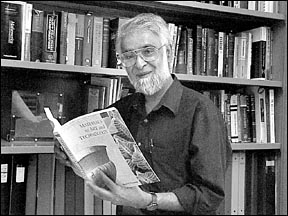|
|
|
|
|
|
INSIDE IOWA STATE March 9, 2001 Textbook examines the science behind sculpture techniquesWhen Rohit Trivedi gazes at a metal sculpture, he appreciates more than the piece's aesthetic qualities.His eye discerns thousands of years worth of processing techniques handed down from generation to generation. Today's artists and artisans use these techniques to express their visions through metals and ceramics, although many of them aren't aware of the history or science behind the materials. Trivedi, a senior scientist at Ames Laboratory and a distinguished professor of materials science and engineering, is trying to bridge that gap. His book, Materials in Art and Technology, describes the evolution of materials-processing techniques dating back to the discovery of fire. "Many of the techniques we use today were developed very early in civilization, except for those that require electricity or electronics," Trivedi said. "Casting, joining, forging -- all of these techniques were nicely developed by the early artisans. We have only perfected these techniques." Artists aren't the only ones who use the techniques. Scientists and manufacturers use them to produce metal and ceramic objects. For example, a casting method used centuries ago to make small objects, sculptures and jewelry is the same process by which turbine blades are made for jet engines, he said. Trivedi notes that through the ages it has been craftsmen -- not scientists -- who first began to take advantage of the properties of metals and ceramics. He marvels at the ingenuity of past generations in learning to manipulate materials without technologies available today. "In some cases, they did things that we could not reproduce. We don't know how they did it," he said. "It's amazing that, even without knowing science, they learned a lot of the scientific principles just through trial and error." Trivedi's book, published in 1998, is based on a course he taught for 20 years at Iowa State. The inspiration for the course came from an ISU art teacher who mentioned that he couldn't produce satisfactory metal castings on cloudy days. Trivedi explained that the problem wasn't the clouds -- it was the humidity. The moisture in the air was absorbing hydrogen, causing bubbles in the castings. The art teacher asked Trivedi to teach a basic materials science course to his students. That first class was such a hit that students from throughout campus wanted to enroll. "The challenge was to put together this course without using mathematics or complex science because many of the students hadn't taken advanced science or math courses," Trivedi said. "I tried to separate scientific concepts from mathematical equations so that they could learn science through the ideas rather than formulas, and that's what appealed to them. "It was science without really studying science." Because he couldn't find a suitable textbook, Trivedi drew on his scientific background, as well as his love of art, to develop course materials. During frequent trips to museums and galleries, he looked for artwork to illustrate various processing and coloring techniques. For instance, Trivedi points out that a towering metal sculpture designed by Pablo Picasso wouldn't be possible without arc welding. "The history of technology has a strong connection with the type of objects that artists could make in order to express their ideas," he said. "Arc welding allowed Picasso to make a sculpture that couldn't have been easily made with other techniques." After two decades of teaching the course, Trivedi wanted to devote more time to other courses and his research. He wrote the book to serve as a manual for anyone -- students, artists and hobbyists -- interested in the background of the processing techniques. He also assembled a companion book of laboratory experiments to illustrate the processing principles. Reprinted with permission from Insider, newsletter of Ames Laboratory.
|
|
Ames, Iowa 50011, (515) 294-4111 Published by: University Relations, online@iastate.edu Copyright © 1995-2001, Iowa State University. All rights reserved. |
